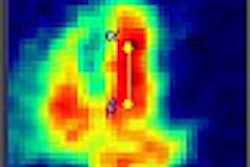Researchers at the University of California, Los Angeles, have come up with some powerful reasons to justify the use of FDG-PET as an adjunct in the diagnosis of Alzheimer's disease (AD).
In elderly patients demonstrating mild cognitive decline, assessment with PET cut the misdiagnosis rate of AD by half, the study concluded, resulting in better patient management and reduced spending on nursing-home care.
Of course, the Centers for Medicare and Medicaid Services (CMS) doesn't pay for the modality to evaluate dementia just yet, but studies such as this one could someday prove persuasive.
Dr. Daniel Silverman and associates sought to assess the relative value of evaluating these patients with PET by comparing it with the standard approach of periodic evidence-based reviews of cognitive function over several years. They noted that both approaches were based on the guidelines and recommendations of the American Academy of Neurology in St. Paul, MN.
Dementia, a problem that worsens with each increase in life expectancy, exacts a huge toll on societal health and welfare, the authors wrote. Alzheimer's disease, the most common form of dementia, affects close to 8% of those 65 and older, and up to 30% of those 85 and older. Alzheimer’s-related treatment costs upwards of $90 billion a year in the U.S. alone.
"The need for early accurate diagnoses has become even more important, now that several prescription medications for the treatment of mild to moderate AD are available," the authors wrote.
Indeed, cholinergic and other agents have been shown to result in global changes in cognition, behavior, and functional abilities, which decrease the burden on caregivers. But the treatments cannot be prescribed without a definitive diagnosis of AD, making PET an essential step for the provision of aggressive care in these patients, the authors stated.
"Investigations that have examined...long-term (treatment effects) indicate that drug treatment produces an average delay in cognitive decline in AD patients of 9 to 12 months," the authors wrote, "and a delay in the need for institutionalization of 18 months on average."
In the retrospective study, the researchers assessed the relative value of PET compared with conventional clinical assessment. They assessed the latter approach by analyzing a study of 134 patients who had presented with new-onset dementia within the previous year (Molecular Imaging and Biology, July-August 2002, Vol. 4:11).
Conventional assessment consisted of a complete standardized diagnostic workup, including a comprehensive medical history and physical, neurological examination, neuropsychologic testing, laboratory tests, structural neuroimaging, and an average of three years of repeated clinical follow-up. The most recent AAN statistical data were used to determine the prevalence of AD in this study cohort.
The sensitivity of the non-PET approach for the diagnosis of AD was 83%-85%, with specificity of 55%, after allowing for a conservative bias that favored conventional assessment, the group wrote.
To assess the diagnostic accuracy of PET, the group relied on a pooled analysis of three previous studies. Each study had provided histopathologically confirmed diagnoses of AD using PET in elderly individuals presenting with early-stage dementia. Overall, PET had 92% sensitivity and 71% specificity for the diagnosis of AD. Unlike the conventional approach, diagnosis with PET was based on a single exam performed once, at an early stage of disease.
The group then used formalized tools of decision analysis to compare the two approaches, gauging the sensitivity, specificity, and overall accuracy of the two approaches. A similar analysis was carried out to compare the financial costs incurred per correct diagnosis with both approaches.
They found that for every 100 patients with early cognitive decline, the conventional approach would have produced 23 false-positive and 8 false-negative diagnoses of AD. A clinical benefit-risk analysis showed that PET would have prevented 11/23 false positives and 5/8 false negatives. Then Silverman and colleagues turned to the costs associated with these incorrect diagnoses.
"Here we explicitly access the impact upon clinical outcomes, reporting for each approach the number of months incurred of avoidable nursing-home care for patients falsely diagnosed with AD, (1) in whom the diagnosis was missed, and (2) of unnecessary anticholinesterase pharmacotherapy per year for patients falsely diagnosed with AD, for patients treated according to AAN recommendations." The outcome measures were then quantified from a societal perspective based on accepted methods of decision-tree analysis.
According to the results, for every 100 patients evaluated, conventional assessment would lead to 74 months of potentially avoidable nursing home care, and 276 months of needless anticholinesterase therapy for patients with false-positive AD diagnoses, the group wrote.
"In comparison, for every 100 patients evaluated and treated (with PET), there would be 28 months of potentially avoidable nursing home care, and 142 months of annual anticholinesterase therapy for patients falsely diagnosed with AD, amounting to a 62% reduction in the number of avoidable months of nursing home care that would be needed, cutting by nearly half the morbidity associated with adverse effects of anticholinesterase therapy ... in patients falsely diagnosed with AD."
Anticholinesterase therapy can produce minor negative side effects, such as vomiting, nausea, and diarrhea, although serious events such as bradycardia and syncope are also occasionally seen, the authors reported.
In terms of quality of life, the group considered the potential drawbacks of unneeded therapy to be less problematic than those associated with unneeded nursing-home care, especially in light of studies concluding that a delay in pharmacologic therapy for AD patients can significantly worsen their long-term prognosis.
"As AD is increasingly recognized as a pharmacologically treatable dementia, it is becoming less tenable to take a watchful waiting approach to making this diagnosis; even a one-year delay in reaching a therapeutic decision may compromise patient outcome," they wrote.
Moreover, if accurate diagnoses are provided early on, "patients can be spared the repeated batteries of diagnostic tests often performed over extended periods of time, and they and their physicians would less often experience the frustrations of ambiguous diagnostic conclusions."
By Eric BarnesAuntMinnie.com staff writer
October 21, 2002
Related Reading
U.S. census figures indicate tripling of Alzheimer's cases by 2050, July 25, 2002
FDG-PET depicts metabolic patterns of Alzheimer's in young adults, July 24, 2002
Imaging agent plus PET visualizes Alzheimer’s marker, July 23, 2002
CMS panel dashes hopes for PET Alzheimer’s payments, April 22, 2002
U.S. gives thumbs-down on PET for Alzheimer's, January 11, 2002
Copyright © 2002 AuntMinnie.com




















